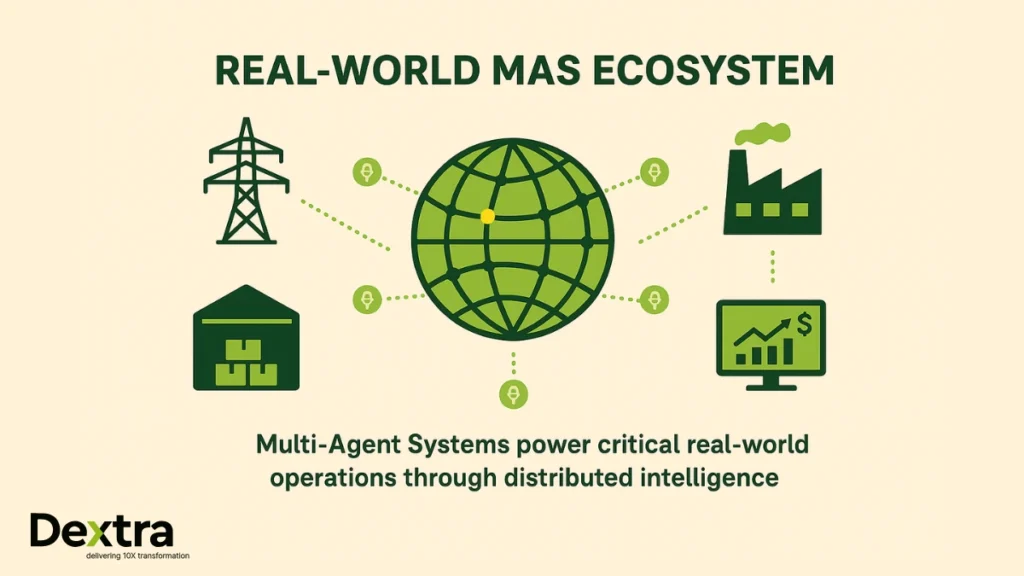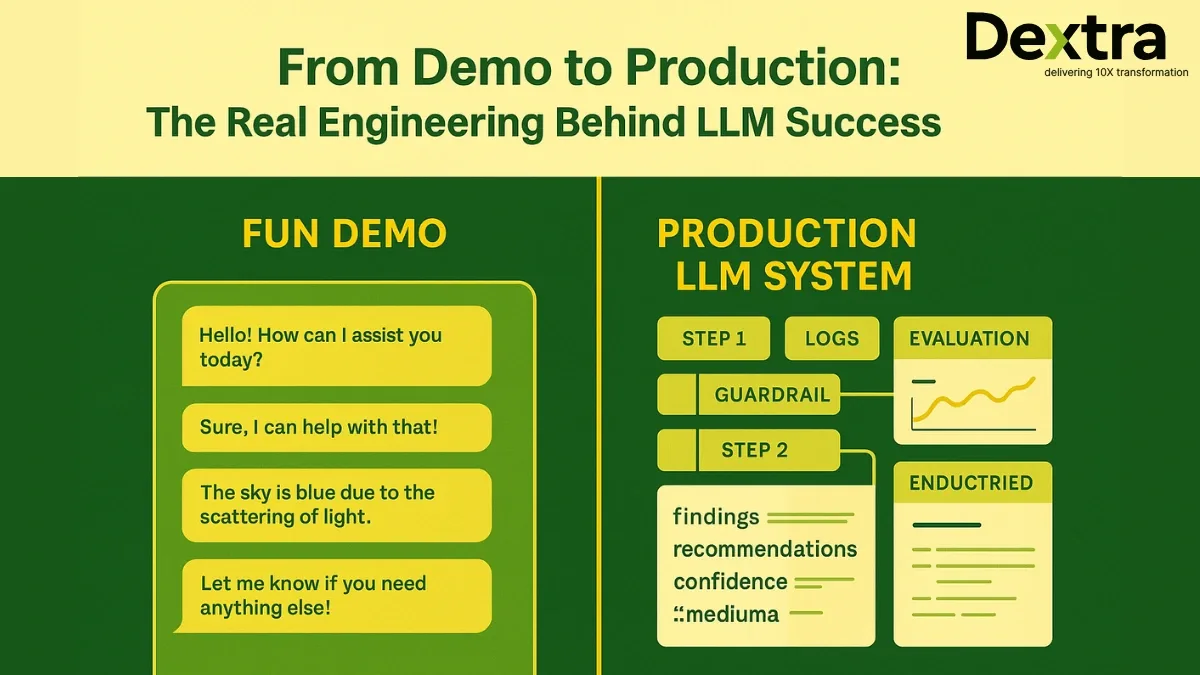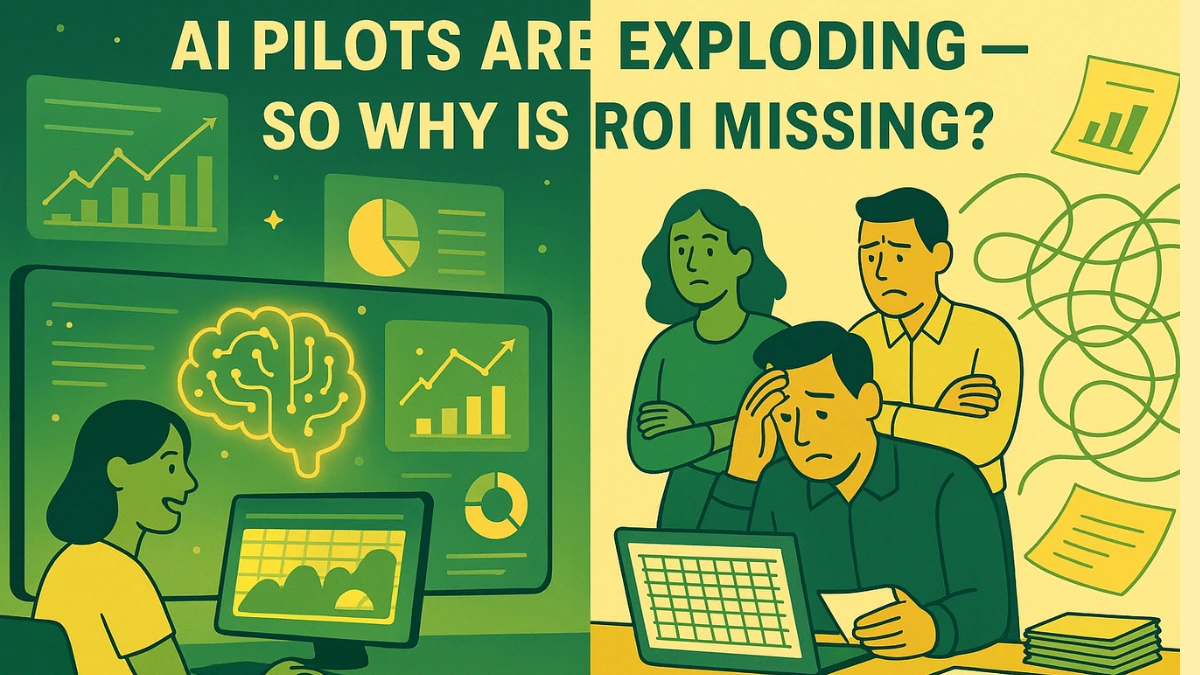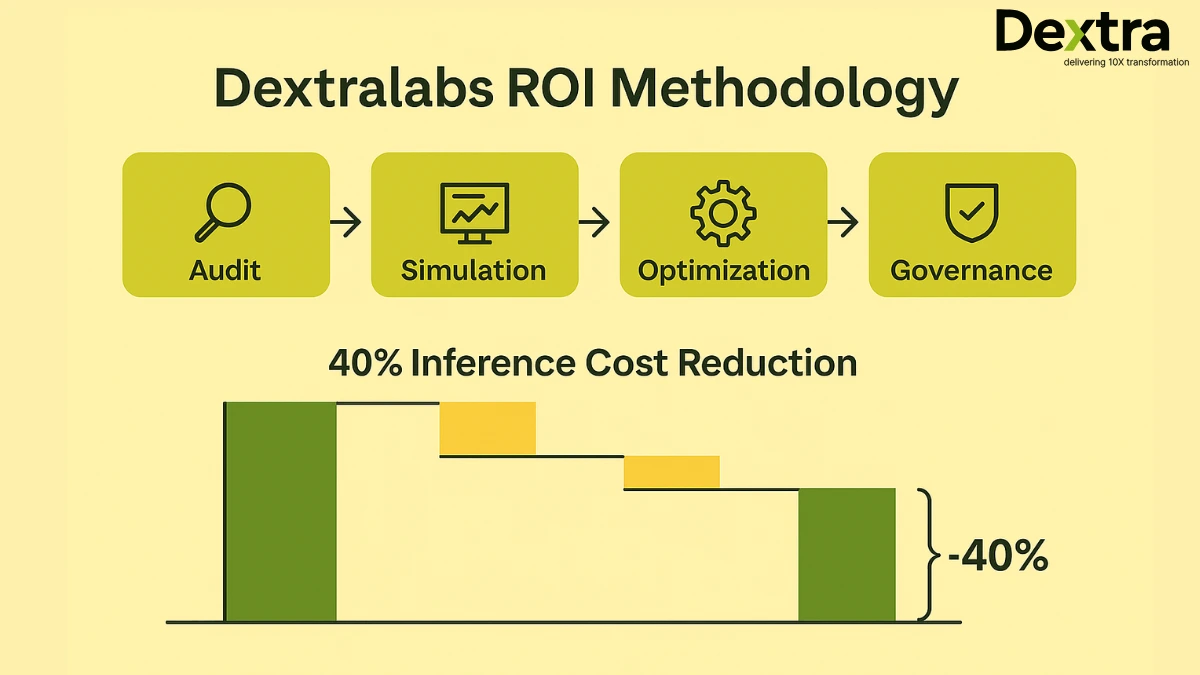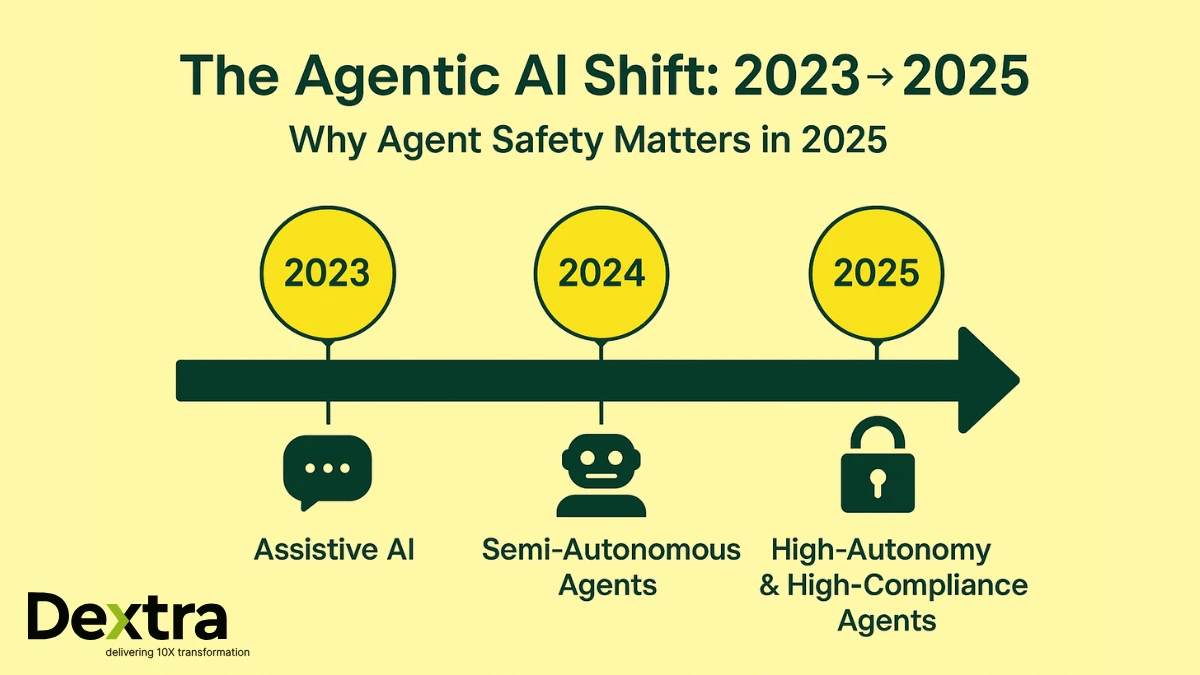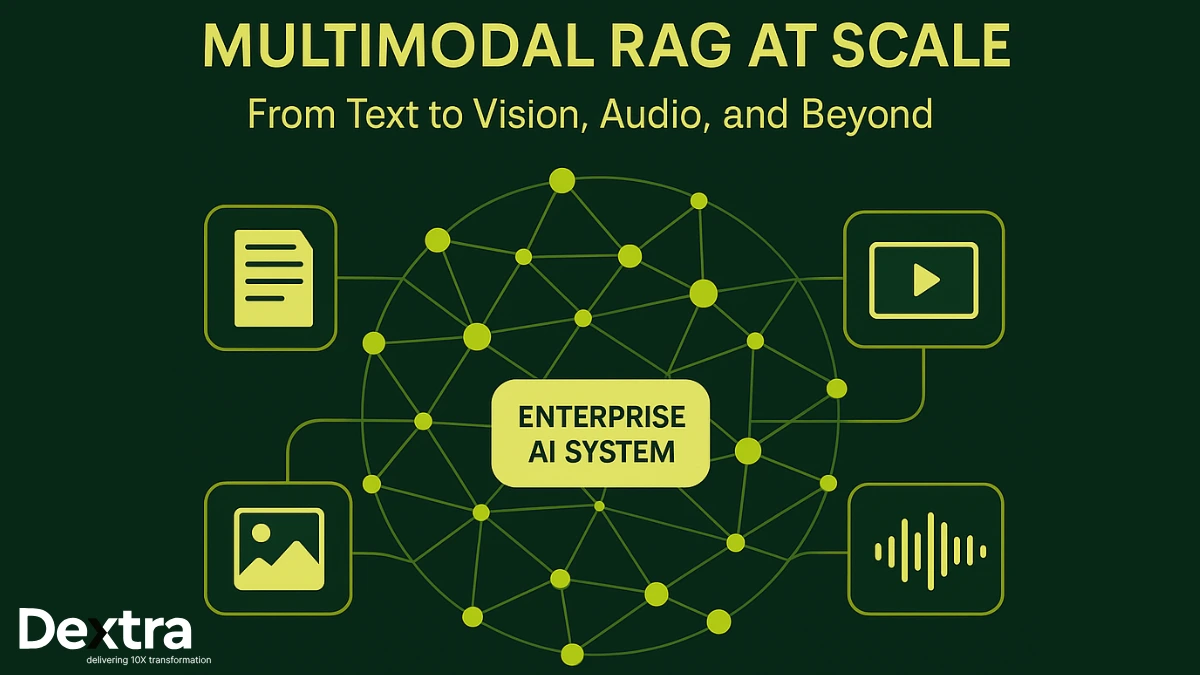Every day, critical systems, whether national power grids or global logistics networks, rely on intelligent agents working together behind the scenes. These agents aren’t isolated AI bots acting alone; instead, they form what’s known as a Multi Agent Systems (MAS): a team of autonomous programs capable of achieving what single entities cannot.
Why does this matter? As real-world circumstances become more dynamic and unpredictable, coordination and adaptability have become crucial. Distributed intelligence and real-time response are two benefits of multi-agent systems. As one of the best AI consulting companies for enterprises and startups across the USA, UK, and beyond, Dextra Labs specialize in designing and deploying Agentic AI solutions and multi-agent architectures that deliver real-time adaptability, distributed intelligence, and mission-critical reliability. They are the driving force behind innovative concepts in resource management, algorithmic trading, and next-generation robotics.
The impact is quantifiable: It says that by 2028, 33% of enterprise software applications will include agentic AI, up from less than 1% in 2024. It also notes that ~15% of day-to-day work decisions will be made autonomously.
By developing MAS-driven architectures and integrating LLM-powered agents, our engineers at Dextralabs help enterprises and startups implement intelligent, autonomous solutions that scale seamlessly across complex business ecosystems. Whether it’s LLM deployment, AI agent development, or custom agentic workflows, Dextralabs delivers end-to-end AI consulting for real-world impact.
Empower Your Systems with Agentic Intelligence
At Dextralabs, we build intelligent Multi-Agent Systems that enhance autonomy, optimize decisions, and scale enterprise performance.
Partner with Dextralabs TodayCore Concepts of Multi Agent Systems
Let’s look at the core concepts of multi-agent systems:
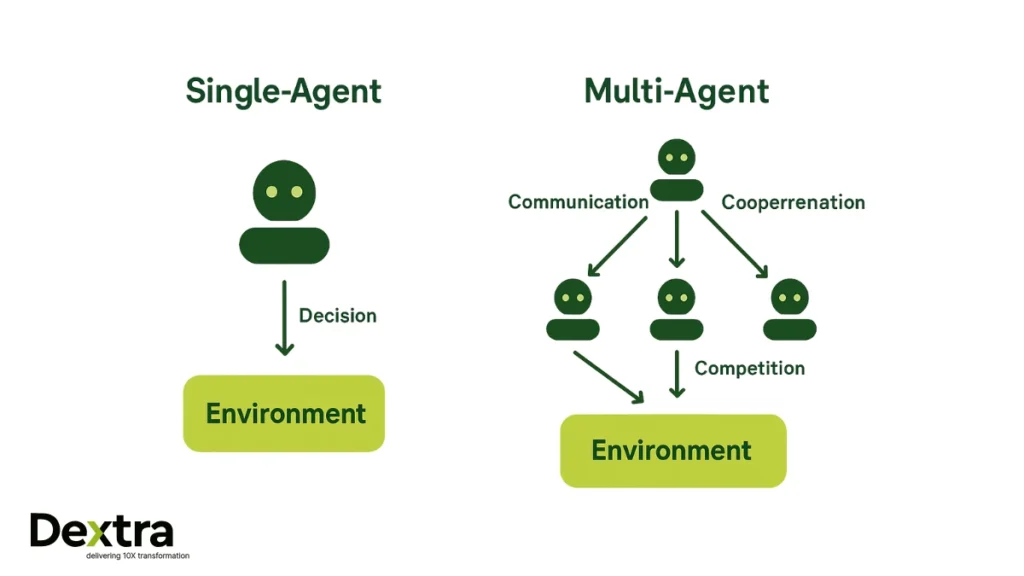
1. Dissecting the Multi-Agent Paradigm
What is a multi-agent system? At its core, a MAS is a collection of autonomous, interacting software entities called agents. Each agent operates with local perception and decision-making, but is embedded within a network where global behavior arises from interaction patterns; negotiation, cooperation, and competition. The crucial difference from single-agent models is:
- Distributed Intelligence: Control, sensing, and decision-making are inherently decentralized.
- Concurrent Problem Solving: Agents perform operations in parallel, reducing overall latency.
- Emergent Properties: System-level intelligence and adaptability result from agent coordination, not hardcoded directives.
2. Agent Specialization
MAS often deploy a combination of agent types to optimize both reactivity and deliberation:
- Reactive Agents: Minimal memory footprint and quick sensor-to-actuator loops for real-time control.
- Deliberative Agents: Use BDI (Belief-Desire-Intention) architectures to plan multi-step strategies, maintain inner models, and adjust to non-stationary environments.
- Hybrid Agents: Suitable for safety-critical systems, they are layered for both quick response and long-term planning.
The Anatomy of Advanced MAS (System Modules and Technical Roles)
Precision engineering of MAS requires the orchestration of the following components:
| Component | Description | Function |
| Agent | Autonomous, adaptive software entity | Perceives environment, reasons, acts, and learns |
| Communication Middleware | Standardized messaging infrastructure (JADE, SPADE, FIPA-ACL) | Handles discovery, encryption, serialization, and routing |
| Coordination Layer | Distributed scheduling and negotiation protocols | Implements auctions, voting, and distributed task/resource assignment |
| Environment Module | Abstracts the physical or simulated world | Maintains state, applies actions, handles observability |
| Machine Learning Engine | RL/federated learning architectures | Enables agents to improve policy or share knowledge dynamically |
| Security & Trust Module | Sandboxing, authentication, and reputation scoring | Defends against malicious or faulty agents |
How do these interact?
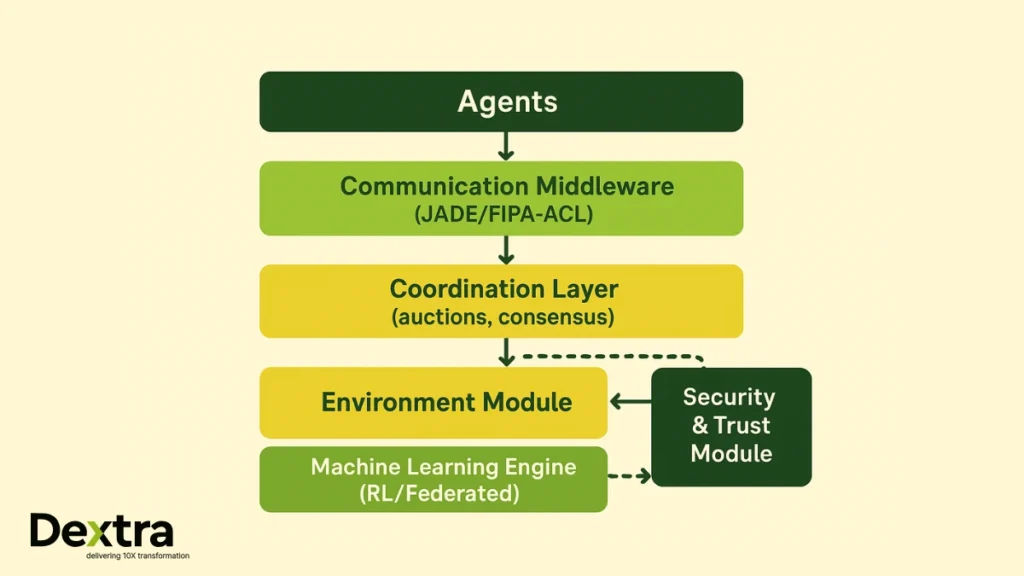
- Each agent senses the environment, processes the input via internal models, communicates intents or outcomes via the middleware, collaborates or competes through the coordination layer, and iteratively adapts using feedback-driven learning.
- The coordination layer resolves conflicts and allocates roles using negotiation, consensus, or auction protocols.
- The security module isolates malicious behaviors, ensuring system integrity even when environments are open or partially controlled.
At Dextralabs, our AI engineering team leverages industry-standard middleware like JADE and FIPA-ACL, combined with reinforcement learning and federated learning frameworks, to design MAS architectures that are robust, secure, and adaptive for sectors like fintech, logistics, and energy.
Architectures and Decision Models
Have a look at the architectures and decision models:
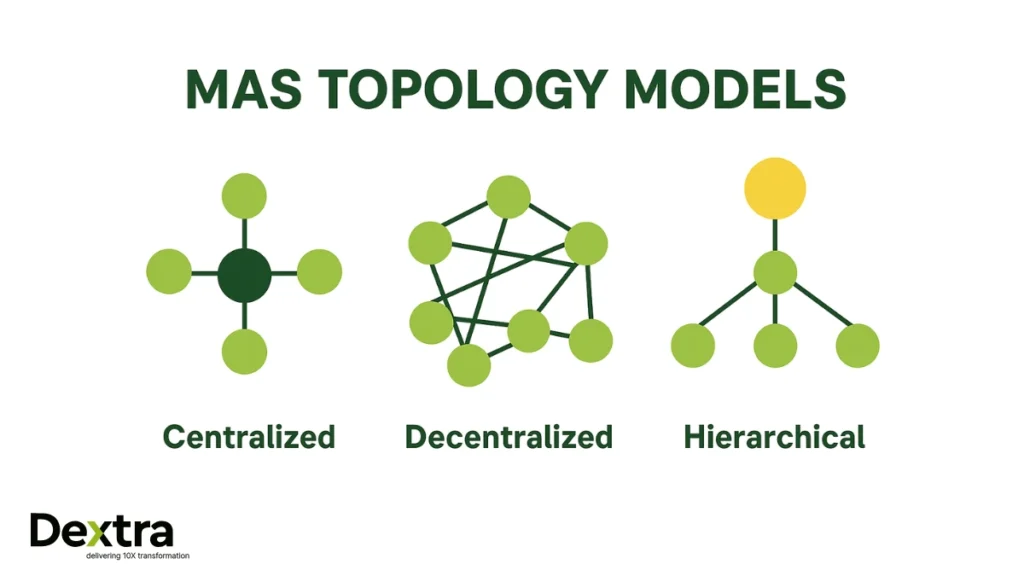
Information Flow Topologies
- Centralized: Coordination decisions pass through a single authority, simplifying scheduling but limiting scalability and robustness.
- Decentralized: Agents are peers in a mesh, sharing state and synchronizing tasks locally; robust to failure, optimal for large-scale implementations.
- Hierarchical: Supervisors delegate to clusters; combines the benefits of both, enabling modular upscaling while still allowing for local optimization.
BDI – The Deliberative Standard
The BDI (Belief-Desire-Intention) agent is widely deployed for tasks requiring reasoning:
- Beliefs: A Dynamic knowledge base constructed from perception and communication.
- Desires: Possible goals; may be conflicting, requiring preference handling.
- Intentions: Concrete plans or commitments, updated in response to environmental feedback.
Distributed BDI engines (using, e.g., AgentSpeak(L), JACK) allow for real-time, decentralized deliberation even as agents scale into the hundreds or thousands.
Tackling Complex Tasks: The MAS Approach
MAS excels where complexity and decentralization intersect, making them indispensable in domains like distributed resource scheduling, resilient infrastructure, and large-scale optimization.
Why Use Multi-Agent?
- Fault Tolerance: Local failures do not cascade. If an agent drops out, others adapt to cover its role.
- Throughput: Tasks are processed nearly linearly with the number of agents, efficiency scaling with available compute and network.
- Adaptability: New agents can join/leave at runtime (open systems) without reprogramming or downtime.
Task Decomposition & Multi-Agent Search
What is multi-agent search? Unlike single-agent search, in which one agent explores possible solutions sequentially, multi-agent search partitions the problem. Agents individually or collaboratively search different regions of the problem space and share partial finds, enabling rapid global convergence even in high-dimensional domains.
Coordination in Action
- Task partitioning: Decompose objectives into subtasks for assignment to specialized agents.
- Distributed auctions: Agents bid for subtasks based on capabilities; optimal allocation via protocols like Contract Net
- Consensus mechanisms: Use distributed algorithms (e.g., Paxos, Raft) to achieve a consistent system state in the presence of delays or failures.
Advanced Capabilities: Learning and Emergence
Let’s comprehend the advanced capabilities of MAS:
- Reinforcement Learning (RL): Agents employ RL algorithms like Q-learning and DDPG to find the best policy by trying different things and getting rewards that are delayed or random.
- Federated Learning: Multiple agents train local models and share parameter updates (not raw data). This is very important for privacy and following the rules in finance or healthcare.
- Emergent Intelligence: Simple rules that apply to individuals can lead to global patterns, such as swarming, flocking, or collective optimization, as demonstrated in ant colony routing or drone coordination (ACO, PSO).
Real-World MAS Applications:
Have a look at real-world applications of Multi-Agent Systems:
1. Smarter Traffic Lights in Pittsburgh
In Pittsburgh, the SURTRAC system was installed at intersections to reduce traffic jams. Each traffic light acts as an independent “agent,” deciding when to change based on live traffic around it, while still coordinating with nearby intersections. This decentralized approach cut travel times by 25% and reduced wait times by about 40% for drivers.
2. Smart Microgrids for Energy Management
In hybrid microgrids that integrated solar, batteries, and conventional power, researchers evaluated a multi-agent control system. Every part of this system, such as storage units or solar panels, has its own agent. These agents kept the supply and demand in balance in real time without a central controller. The result was more reliable power, faster response to sudden changes, and better use of renewables.
3. Logistics and Autonomous Fleets
In manufacturing and warehouses, fleets of autonomous mobile robots (AMRs) are managed with MAS approaches. Each robot is an agent that negotiates routes and tasks with the others. In one large-scale deployment, MAS-based planning led to a 30% reduction in the number of robots needed, cutting costs and improving efficiency.
4. Distributed Energy in Switzerland (Commelec Project)
The Commelec framework developed at EPFL in Switzerland gives each device on the grid (solar panels, EV chargers, batteries, etc.) its own agent. These agents don’t have one person in charge of them; instead, they work together to keep the grid stable in real time. This has been tested in live pilots and it has been shown to keep the grid stable even when a lot of renewable energy is pouring in.
Building on these global innovations, Dextralabs has been helping enterprises integrate MAS-based frameworks with LLM-powered reasoning and autonomous agent orchestration, enabling smarter operations, faster decision-making, and reduced operational overhead.
Multi-Agent Search vs. Single-Agent Search
The main difference between multi-agent search and single-agent search is that single-agent search finds an optimal path in an environment without opponents, while multi-agent search considers other agents’ (often adversarial) actions when planning.
Let’s have a look at its quick comparison:
| Feature | Single-Agent | Multi-Agent |
| Scalability | Low | High |
| Robustness | Low | High |
| Communication Overhead | Low | Moderate/High |
| Solution Speed | Often slow | Often near-linear with agents |
Challenges and Research Horizons
Have a look at the challenges and research momentum of MAS:
Current Technical Challenges
- Network Overhead: Communication grows with agent count; adaptive protocols (compression, multicast) are vital.
- Security: Byzantine and malicious agents require trust, authentication, and isolation subsystems.
- Standardization: Fragmented middleware/protocol ecosystems complicate cross-platform deployments.
- Dynamic Membership: Seamless runtime joining/leaving without loss of global coherence.
Research Momentum
- Deep RL + MAS: Integration for autonomous trading, robotics, and cyber-defense.
- Quantum-Accelerated MAS: Leveraging quantum resources for unbreakable security and radical speedups.
- Human-Agent Collaboration: UI/UX frameworks for seamless interaction in hybrid teams.
At Dextralabs, our R&D pipeline focuses on merging Deep RL with Agentic AI, designing quantum-secure MAS architectures, and pioneering LLM integration for dynamic reasoning. Our consulting team partners with enterprises to future-proof their operations with scalable, intelligent systems.
Conclusion
Multi-agent systems are the most advanced kind of AI that is distributed, adaptable, and scalable. Autonomy, local learning, and collective coordination work together to improve performance across industries. This is shown by expected adoption rates of over 65% for enterprise AI and operational improvements of over 25% in logistics and smart environments.
At Dextralabs, we don’t just build AI — we architect intelligent ecosystems. From LLM deployment and AI agent development to full-scale multi-agent orchestration, our consulting solutions help enterprises and startups harness Agentic AI for sustainable competitive advantage.
Get in touch with Dextralabs to explore how MAS can redefine your business intelligence, operations, and automation.
Frequently Asked Questions (FAQs):
Q1. What is a Multi-Agent System (MAS)?
A Multi-Agent System is a network of autonomous, interactive software agents that collaborate or compete to solve complex problems. Unlike single-agent models, MAS are decentralized, scalable, and fault-tolerant, making them ideal for real-time, distributed environments.
Q2. How are Multi-Agent Systems used in real-world industries?
MAS are widely applied in traffic optimization, energy management, logistics, finance, and robotics. For example, smart traffic lights in Pittsburgh use MAS to reduce congestion, while energy microgrids use MAS to balance supply and demand autonomously.
Q3. How can Dextralabs help my business adopt MAS or Agentic AI solutions?
Dextralabs offers AI consulting services focused on LLM implementation, AI agent development, and multi-agent orchestration. Our team helps enterprises design MAS frameworks that enhance automation, resilience, and decision-making.
Q4. What is the role of Large Language Models (LLMs) in MAS?
LLMs can serve as reasoning engines within agents, enabling natural language understanding, context-aware decisions, and collaborative problem-solving. Dextralabs integrates LLMs into MAS to create intelligent, explainable, and adaptive systems.
Q5. Are MAS secure and reliable?
Yes. Modern MAS include security modules for authentication, trust scoring, and isolation of malicious agents. Dextralabs employs sandboxed architectures and federated learning to ensure data privacy, compliance, and robust operation.
Q6. What makes Dextralabs different from other AI consulting companies?
Dextralabs combines deep expertise in AI agent development, LLM deployment, and enterprise-grade MAS design. With clients across the USA, UK, UAE, and Asia, we deliver tailored solutions that align technical innovation with strategic business goals.

